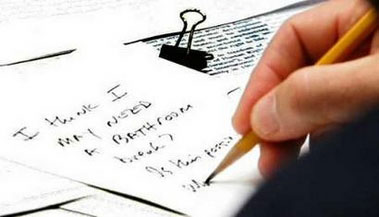
(Rick Wilking, Reuters 09-14-05)
Today's must read/must see is Errol Morris' fabulous roundup of embarrassing ("defining," he calls them) photos of George Bush. Morris sat down with representatives of the big three, (Reuters, AFP, AP) and had them pick the most telling shots. You may or may not be surprised by the overlaps: all three pick shots of Andrew Card breaking the news of the 9-11 attacks, for instance. All three, too, pick shots of Bush looking his most retarded (remember the famous locked door?) as characteristic.
My favorite, though, is the analysis of Reuters' famous shot (above) of Bush's note asking Condi's permission to go tinkle:
JIM BOURG: One of the pictures that created a storm of controversy for us here at Reuters because it was an exclusive picture, was the picture of Bush writing the note at the U.N. asking Condi Rice’s permission to go to the bathroom. Do you remember that photo?
ERROL MORRIS: Of course. I had read that there was some controversy about that photograph, that it was enhanced so that you could—
JIM BOURG: No, all we did was darken the paper, darken it down some so that you could actually see that there was any writing on it at all. Anyone who has ever shot pictures in that room at the U.N., and I’m one of them, can tell you then the lighting in that room at the U.N. is absolutely abysmal. The picture was exposed for the skin tones of the president and his jacket as we normally do. And so the paper in front of him was as a result severely overexposed. And all that we ever told anyone we had done, and all that was ever done to the photo, was that the paper was darkened down some so that you could actually see that there was any writing on it at all. Some people, the strongest critics of it, took that and ran with it. Someone having admitted that the photo had been altered in some way, when it wasn’t altered any more than other photos are to either correct the color or lighten a photo which has been shot too dark, or darken a photo which has been shot too light.
ERROL MORRIS: And that photograph was controversial because it showed what?
JIM BOURG: That despite the fact that it was shot in a public place with the president fully aware that there were photographers directly above him, there in the U.N. as there always are, people felt that because of the content of the note, it might be an invasion of his privacy and a cheap shot at him. I think if the content of the note had been different, there likely would have been no controversy at all.
ERROL MORRIS: In these highly orchestrated images, “Mission Accomplished” being the most obvious example, one looks for things that have not been orchestrated, things that are spontaneous, unrehearsed, unplanned.
JIM BOURG: Certainly that’s very much what we are always looking for. It is often the hardest thing to make, covering the president of the United States, to find anything that does, in fact, look spontaneous or unrehearsed because there is a large team of people and staff there at the White House whose job it is to always try to put the president in the best light possible and to insure that things don’t occur which would potentially make him look bad. And also, to try to convey the message that the administration and the president are seeking to convey, not just through what he says, but also through the images as well. That’s the talent of our White House photographers: to be able to work within the constraints that are imposed upon them by the White House staff, but also to fully document what’s going on.
ERROL MORRIS: One of the amazing things about photography is try as you might to control everything, you cannot. The U.N. photograph? Didn’t he have to be aware that he’s being photographed?
JIM BOURG: He was certainly aware that there were photographers behind and above him. There’s no glass between the photographers and the dignitaries, the diplomats and the heads of state there. The U.N. Security Council is not that big a room. The press boxes are one level up and just behind where the leaders and the diplomats sit at the desks. You feel like you’re looming over them. So they’re very clearly aware of the photographers, and that is why we were amazed by some of the reaction, as if we had in some way intruded on a private moment. It was in a most public place being televised live and covered by photographers arrayed around a horseshoe shaped room in all directions around the president.
Suggested soundtrack for reading this article is "Public Image" by PIL:
What you wanted was never made clear
Behind the image was ignorance and fear
You hide behind this public machine
Still follow same old scheme
Public Image
Two sides to every story
Somebody had to stop me
I'm not the same as when I began
It's not a game of monopoly
Public Image
Goodbye!
3 comments:
I think the trio of photos showing Bush afraid or disgusted or frustrated about going out to meet the media tell the story best.
That, and the extreme close up showing all the capillaries on his nose and cheek busted from too much drinking.
The nose knows.
I love the sound of John Lydon in my morning head.
Thank you, PSP!
And the fabulous Errol Morris, too.
Good grief. Making the letters on a white piece of paper visible is called burning, and it's standard procedure in any quality photographic print.
If Dubya doesnt want to be embarrassed, then he needs to stop doing embarrassing things, or lock himself in his new house and never come out.
Post a Comment